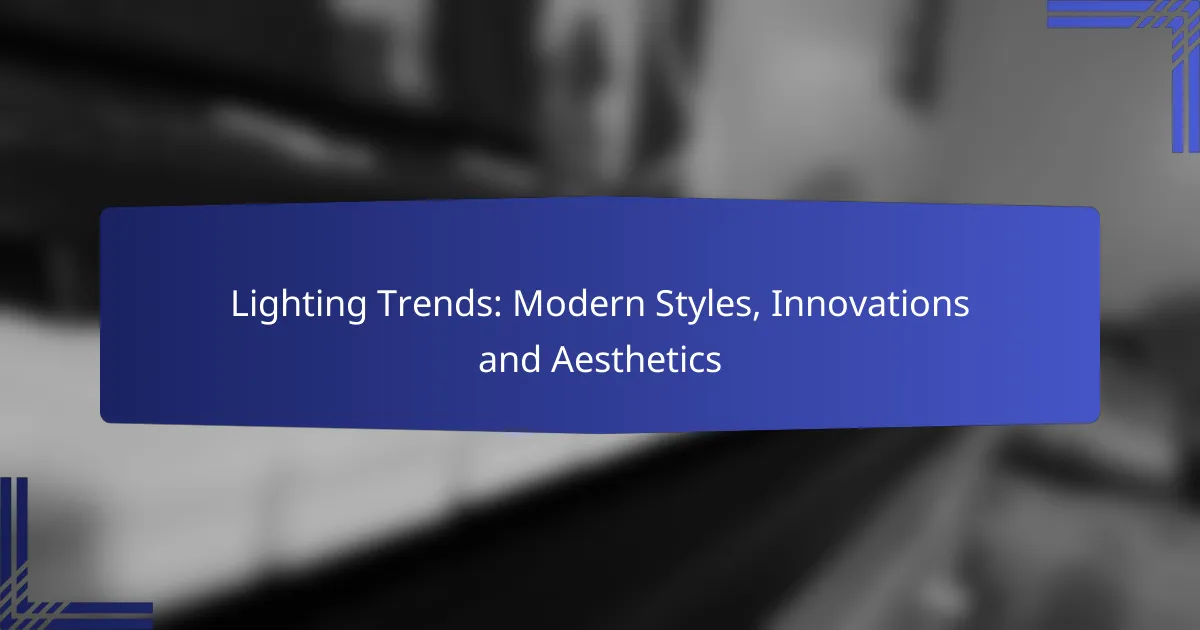In today’s homes, lighting trends emphasize a blend of technology, simplicity, and sustainability, with homeowners increasingly favoring smart systems and minimalist designs. Innovations like LED advancements and smart home integrations not only enhance functionality but also allow for greater control over ambiance. Contemporary styles such as industrial, Scandinavian minimalism, and mid-century modern reflect the diverse aesthetics that define modern living spaces.
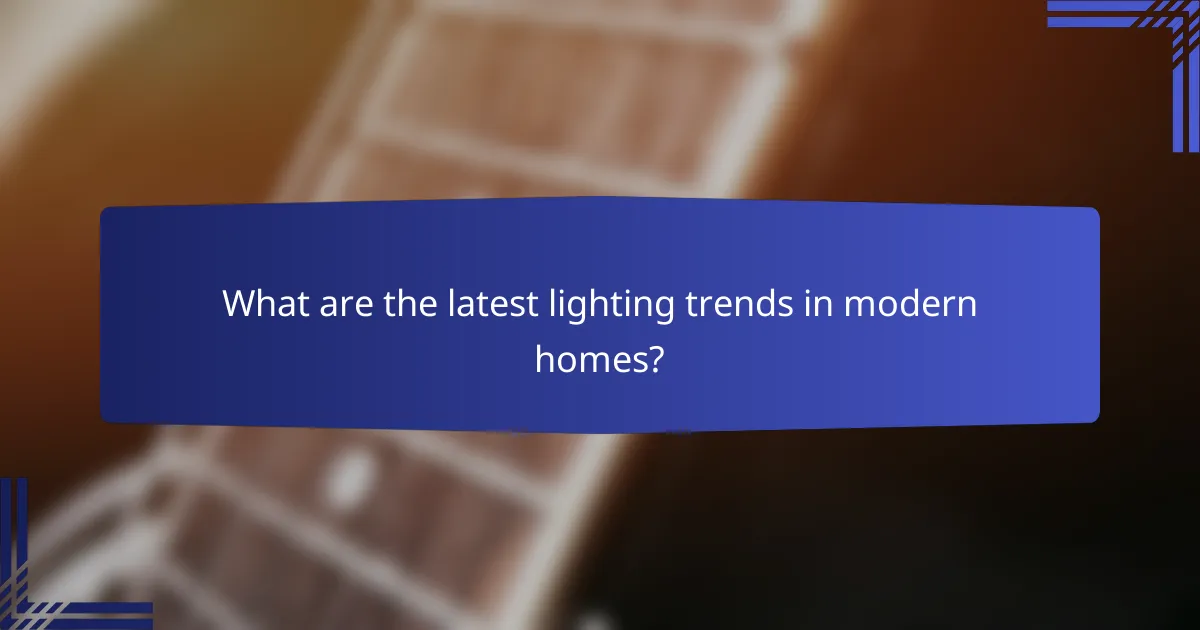
What are the latest lighting trends in modern homes?
The latest lighting trends in modern homes focus on integrating technology, simplicity, sustainability, and nostalgia. Homeowners are increasingly opting for smart systems, minimalist aesthetics, eco-friendly materials, vintage designs, and layered lighting techniques to enhance both functionality and ambiance.
Smart lighting systems
Smart lighting systems allow homeowners to control their lights remotely via smartphones or voice-activated devices. These systems often include features like scheduling, dimming, and color-changing capabilities, providing flexibility and energy efficiency.
When choosing a smart lighting system, consider compatibility with existing home automation setups and the ease of installation. Popular options include Philips Hue and LIFX, which offer a range of bulbs and fixtures that can be tailored to individual preferences.
Minimalist designs
Minimalist lighting designs emphasize simplicity and clean lines, often featuring fixtures that blend seamlessly with modern interiors. These designs prioritize functionality while eliminating unnecessary ornamentation, creating a serene atmosphere.
Common minimalist lighting options include pendant lights with geometric shapes and recessed lighting that highlights architectural features without drawing attention to the fixtures themselves. Choosing neutral colors and materials can enhance this aesthetic.
Eco-friendly materials
Eco-friendly lighting materials are gaining popularity as homeowners seek sustainable options. Fixtures made from recycled metals, bamboo, and energy-efficient LED bulbs reduce environmental impact while providing stylish illumination.
When selecting eco-friendly lighting, look for certifications such as Energy Star, which indicates energy efficiency, and consider the lifecycle of the materials used. Investing in sustainable lighting not only benefits the planet but can also lower energy costs over time.
Vintage-inspired fixtures
Vintage-inspired lighting fixtures bring a sense of nostalgia and character to modern homes. These designs often feature elements from past decades, such as Edison bulbs, wrought iron, and antique finishes, creating a warm and inviting atmosphere.
Incorporating vintage lighting can be as simple as adding a statement chandelier or using retro-style bulbs in contemporary fixtures. Mixing vintage pieces with modern decor can create a unique and personalized space.
Layered lighting techniques
Layered lighting techniques involve combining different types of lighting—ambient, task, and accent—to create a well-lit and versatile space. This approach enhances functionality while allowing for mood adjustments throughout the day.
To implement layered lighting, consider using ceiling fixtures for ambient light, task lights for work areas, and accent lights to highlight artwork or architectural features. A well-planned lighting scheme can significantly improve the overall aesthetic and usability of a room.
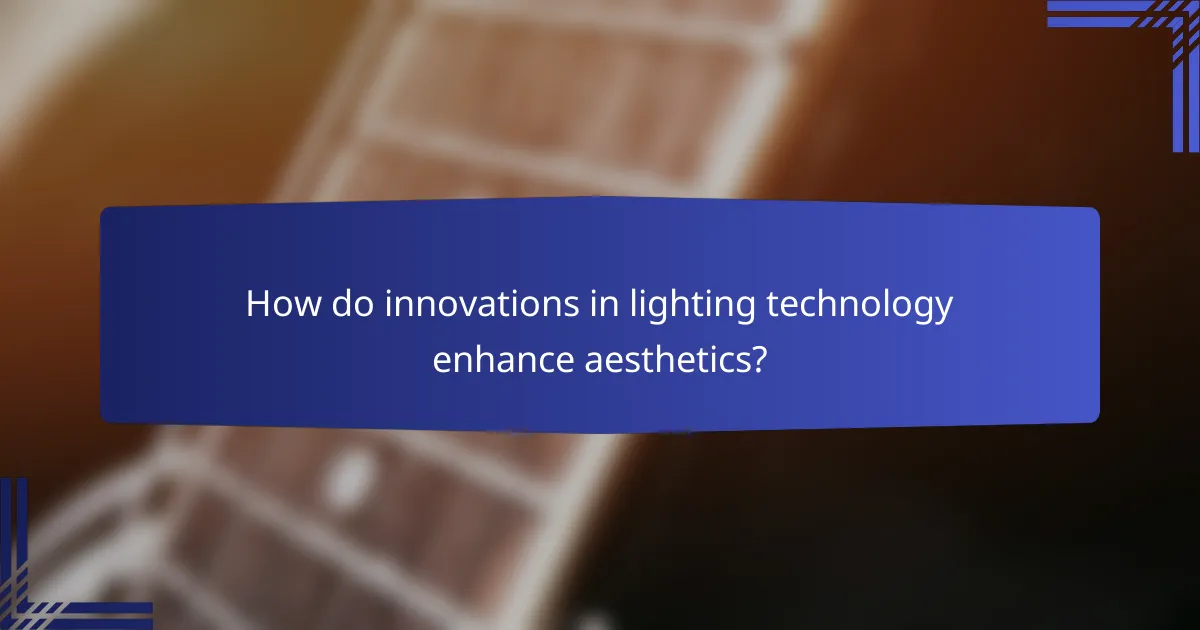
How do innovations in lighting technology enhance aesthetics?
Innovations in lighting technology significantly enhance aesthetics by providing improved functionality, versatility, and design options. Modern lighting solutions, such as LED advancements and smart home integrations, allow for greater control over ambiance and style in various spaces.
LED advancements
LED technology has transformed the lighting industry with its energy efficiency and longevity. These lights consume significantly less power than traditional incandescent bulbs, often lasting tens of thousands of hours, which reduces replacement frequency and waste.
In terms of aesthetics, LEDs offer a wide range of color temperatures, from warm to cool light, allowing homeowners to create the desired mood in any room. Their compact size enables innovative designs, such as recessed lighting and sleek fixtures that blend seamlessly into modern interiors.
Color-changing capabilities
Color-changing lighting systems provide dynamic aesthetics by allowing users to adjust the hue and intensity of their lights. This flexibility can dramatically alter the atmosphere of a space, making it suitable for various occasions, from cozy gatherings to vibrant parties.
Many color-changing lights can be controlled via apps or remote controls, enabling easy customization. Users can choose from millions of colors, enhancing the visual appeal of their environments and allowing for creative expression in interior design.
Integration with smart home systems
Integrating lighting with smart home systems enhances both functionality and aesthetics by enabling automated control and customization. Homeowners can program lighting schedules, adjust brightness, and change colors using voice commands or smartphone apps.
This integration not only improves convenience but also allows for synchronized lighting effects with other smart devices, such as speakers and thermostats. For example, lights can dim automatically when a movie starts, creating a cinematic experience that enhances the overall ambiance of the home.
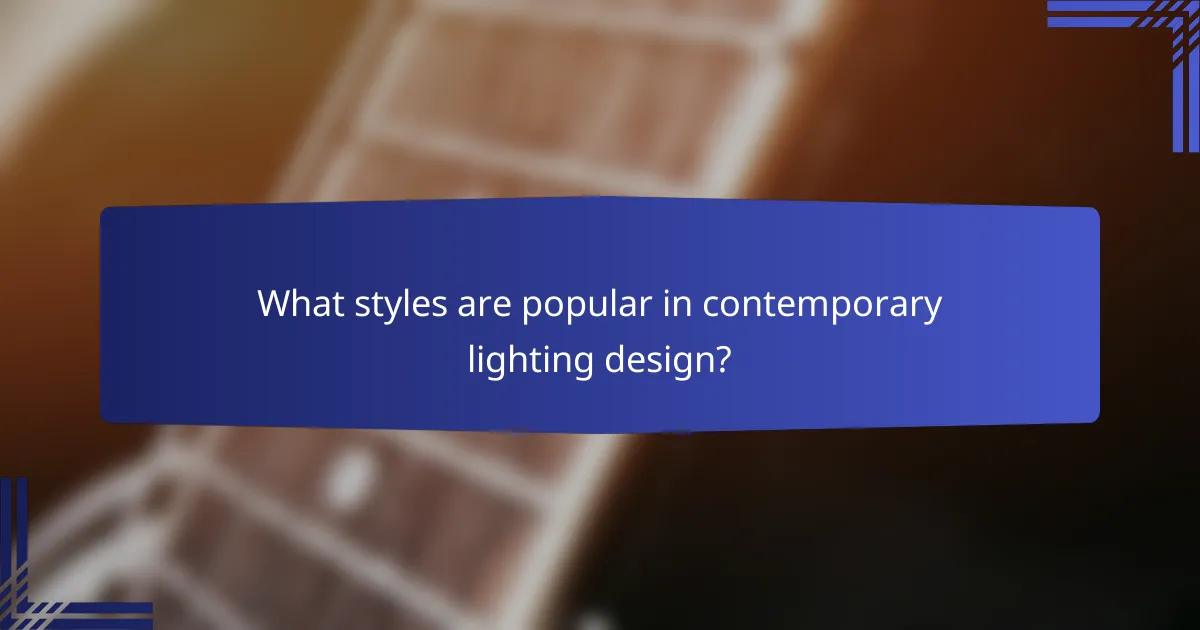
What styles are popular in contemporary lighting design?
Contemporary lighting design features a variety of styles that reflect modern aesthetics and functionality. Popular styles include industrial, Scandinavian minimalism, and mid-century modern, each offering unique characteristics and design philosophies.
Industrial style
Industrial style lighting draws inspiration from factories and warehouses, emphasizing raw materials and a utilitarian aesthetic. Common elements include exposed bulbs, metal fixtures, and distressed finishes, creating a rugged yet stylish look.
When incorporating industrial lighting, consider using pendant lights or sconces made from materials like iron or brass. These fixtures often work well in open spaces and can complement other industrial decor elements, such as reclaimed wood or concrete surfaces.
Scandinavian minimalism
Scandinavian minimalism focuses on simplicity, functionality, and natural materials. This style often features clean lines, neutral colors, and an emphasis on light, making spaces feel airy and inviting.
To achieve a Scandinavian look, opt for fixtures that use wood, glass, or soft metals. Pendant lights with simple geometric shapes or floor lamps with a minimalist design can enhance the overall aesthetic while providing effective illumination.
Mid-century modern
Mid-century modern lighting is characterized by bold forms, vibrant colors, and innovative materials. This style often includes iconic designs that blend functionality with artistic flair, making fixtures a focal point in any room.
When selecting mid-century modern lighting, look for pieces with organic shapes and bright hues. Table lamps with tapered bases or chandeliers featuring starburst designs can add a touch of retro charm while maintaining a contemporary feel.
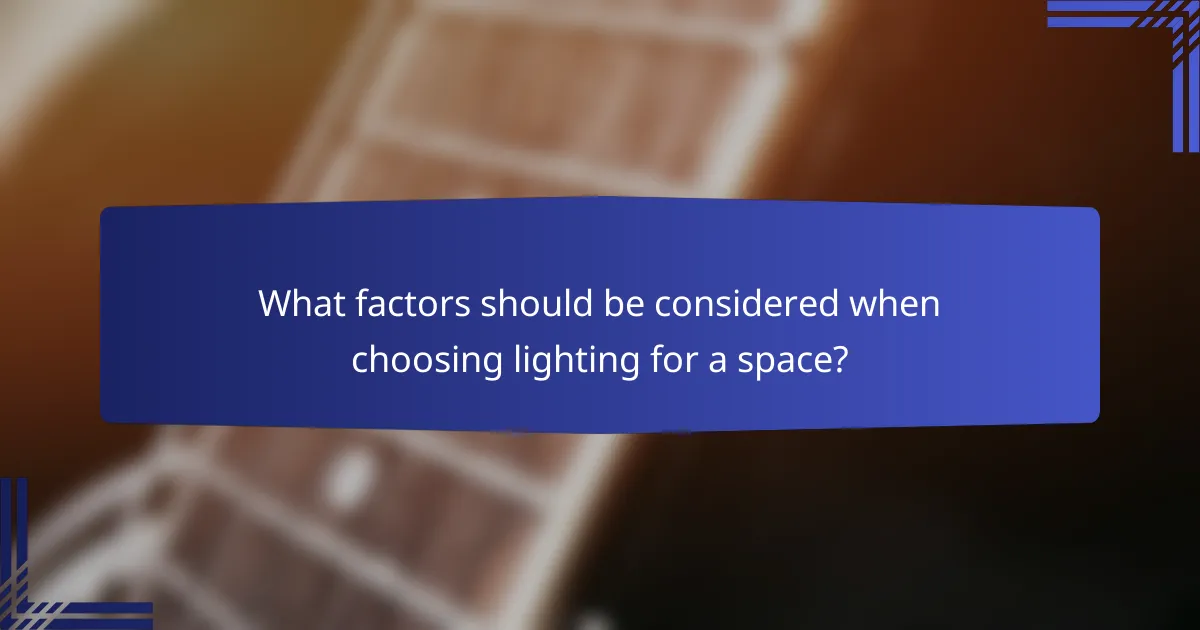
What factors should be considered when choosing lighting for a space?
When selecting lighting for a space, consider the room’s function, ceiling height, and color temperature. These factors significantly influence both the aesthetic appeal and practical functionality of the lighting design.
Room function
The purpose of a room greatly impacts the type of lighting needed. For example, a kitchen may require bright, focused lighting for tasks, while a living room might benefit from softer, ambient lighting for relaxation. Assessing how the space will be used helps in choosing fixtures that enhance usability.
Additionally, consider the activities that will take place in the room. Areas designated for reading or hobbies may need adjustable lighting options, while spaces meant for socializing can utilize layered lighting to create a welcoming atmosphere.
Ceiling height
Ceiling height plays a crucial role in determining the appropriate lighting fixtures. For rooms with low ceilings, flush mount or recessed lighting can provide adequate illumination without overwhelming the space. In contrast, high ceilings allow for pendant lights or chandeliers that can serve as focal points while providing ample light.
As a rule of thumb, aim for fixtures that hang about 30 to 36 inches above the floor in dining areas, ensuring they do not obstruct views or movement. Always consider the scale of the fixture relative to the room’s dimensions to maintain balance.
Color temperature
Color temperature, measured in Kelvins (K), affects the mood and functionality of a space. Warmer tones (around 2700K to 3000K) create a cozy and inviting atmosphere, ideal for living rooms and bedrooms. Cooler tones (4000K to 5000K) are more energizing and suitable for workspaces like offices or kitchens.
When selecting bulbs, consider the overall color scheme of the room. Warmer light can enhance earthy tones, while cooler light can make spaces feel more modern and vibrant. Mixing different color temperatures can create visual interest, but be cautious to maintain harmony throughout the space.

How do lighting trends vary across different regions?
Lighting trends differ significantly across regions due to cultural preferences, economic factors, and environmental conditions. Urban areas often favor modern, sleek designs, while rural settings may lean towards more traditional styles that reflect local heritage.
Urban vs. rural preferences
In urban environments, lighting trends typically emphasize minimalism and functionality, with a focus on energy-efficient LED fixtures and smart lighting systems. These designs often incorporate sleek lines and innovative technologies to enhance modern aesthetics.
Conversely, rural areas may prioritize warmth and charm in their lighting choices, often opting for fixtures made from natural materials like wood or wrought iron. These styles reflect a connection to nature and local craftsmanship, creating a cozy atmosphere that contrasts with the starkness of urban designs.
Climate influences on materials
Climate plays a crucial role in determining the materials used for lighting fixtures. In regions with high humidity, such as coastal areas, materials like stainless steel and weather-resistant plastics are preferred to prevent corrosion. In contrast, dry climates may allow for the use of more delicate materials like glass or ceramics.
Additionally, energy efficiency is often a priority in colder climates, where lighting must not only illuminate but also contribute to heating. This has led to the popularity of fixtures that can accommodate energy-efficient bulbs and provide adequate warmth without excessive energy consumption.
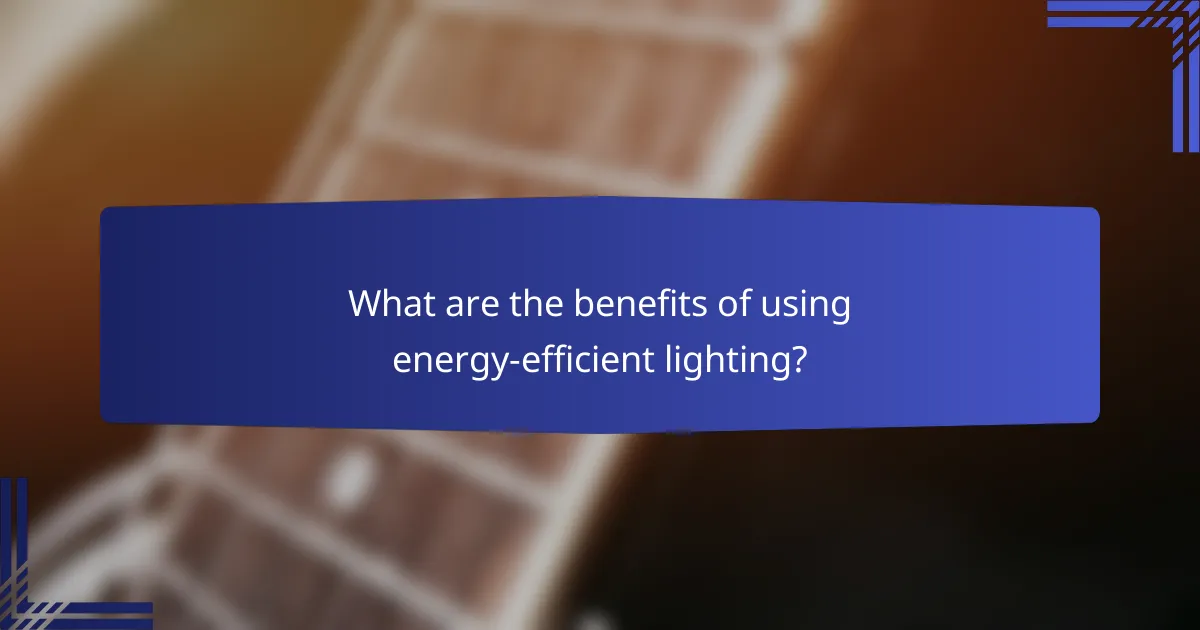
What are the benefits of using energy-efficient lighting?
Energy-efficient lighting offers significant advantages, including lower electricity bills and reduced environmental impact. By utilizing technologies like LED and CFL bulbs, users can save money while contributing to sustainability efforts.
Cost savings
One of the primary benefits of energy-efficient lighting is the cost savings on energy bills. These lighting options consume less electricity, leading to reductions of up to 75% compared to traditional incandescent bulbs. Over time, the initial investment in energy-efficient fixtures is often recouped through lower utility costs.
Additionally, many energy-efficient bulbs have a longer lifespan, which means fewer replacements and maintenance costs. For instance, LED bulbs can last up to 25,000 hours, while incandescent bulbs typically last around 1,000 hours.
Environmental impact
Energy-efficient lighting significantly reduces carbon emissions, as it requires less energy production from fossil fuels. This shift contributes to a decrease in greenhouse gases, helping combat climate change. For example, switching to LED lighting can prevent the release of hundreds of pounds of CO2 per bulb over its lifetime.
Moreover, many energy-efficient bulbs contain fewer hazardous materials compared to traditional options. This reduction not only minimizes environmental pollution but also aligns with regulations in various regions aimed at promoting safer, greener lighting solutions.
